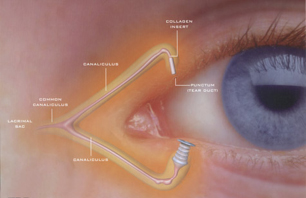What are punctal plugs?
Punctal plugs are microscopic and are placed into the tear drain, called the punctum. We are born with 4 puncta, 2 upper and 2 lower on each eye. Plugs can be placed in either the lower puncta or the lower and upper pucnta, depending on the severity of the dry eye condition. Plugs are placed in the office setting and the procedure is normally painless, but some pressure can be felt. Plug placement takes less than one minute, and no anesthesia is required.
Why do punctal plugs work?
Plugs work for the same reason that a stopper in the drain of a bathtub works. Some people produce too little of the oily tears in the eyelids, called the meibomian glands. The tears evaporate too fast, and the tear gland can over produce watery tears. This is why some people with “dry eyes” often complain of tearing. By placing a plug in the tear drain, more of the tears are retained on the ocular surface, and creating more moisture on the eye. Plugs can also reduce the extra production of tears and reduce tearing.
Are there different types of plugs?
Yes. There are non-disolvable plugs (made of silicone) and disolvable plugs (made of collagen.) We prefer non-disolvable plugs because they can last for many months, providing long term symptom relief. Also, non-disolvable plugs can be removed at any time. The drawbacks to non-disolvable plugs are that some people can feel the plugs and find them uncomfortable. When this occurs, the plugs are removed in the office. (Removal takes less than 1 minute in most cases.)
Disolvable plugs are placed entirely into the tear drain (punctum) and can not be felt after placment. However, disolvable plugs last between 2 – 12 weeks and must be replaced after they disolve. These plugs can not be easily removed, but will disolve over time.
Can I rub my eyes or wear eye make up after punctal plug placment?
Yes.
What are the risks of plug placement?
 Infections are rare, and are treated by removing the plug and using antibiotic eyedrops. The plugs can rarely cause inflammation and scarring of the puncta, creating a permanent closure of the tear drain. Rarely, the punctal plug can prolapse, “get stuck inside” the puncta, and cannot be removed easily.
Infections are rare, and are treated by removing the plug and using antibiotic eyedrops. The plugs can rarely cause inflammation and scarring of the puncta, creating a permanent closure of the tear drain. Rarely, the punctal plug can prolapse, “get stuck inside” the puncta, and cannot be removed easily.
